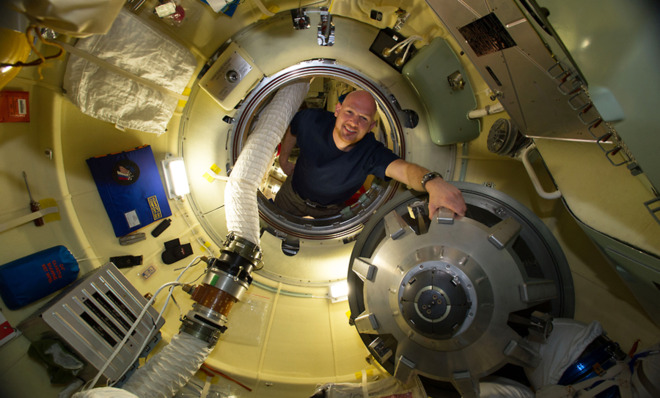The 4 coolest science experiments happening on the International Space Station right now
Yes, a robot is involved


Since its first crew came on board in the year 2000, the International Space Station (ISS) has been one of the most productive research laboratories on (well, off) the planet. Astronauts, cosmonauts, and scientists from 15 different nations have conducted hundreds of experiments over the first 14 years of the ISS's ongoing mission.
And experiments in space often translate into benefits for Earth. "For example, GE now builds new lighter, aircraft engines, because of the technologies we developed in space," says Julie Robinson, chief scientist for the station since 2007.
So what amazing innovations are they working on right now, up there 230 feet above your head? Here are four of Robinson's favorite experiments going on aboard the ISS right now.
The Week
Escape your echo chamber. Get the facts behind the news, plus analysis from multiple perspectives.

Sign up for The Week's Free Newsletters
From our morning news briefing to a weekly Good News Newsletter, get the best of The Week delivered directly to your inbox.
From our morning news briefing to a weekly Good News Newsletter, get the best of The Week delivered directly to your inbox.
Working on: 3D printing in zero G
The ISS crew is testing 3D printing processes as a first step towards establishing a working machine shop in space. This would allow for in-space manufacturing, making onboard experiments more flexible, and crew members less reliant on ground support.
"Let's face it, 3D printing is the manufacturing technology for the future and an incredibly valuable tool for future deep space exploration," Robinson says. "If something breaks on board a space vehicle, we are just one spare part away from an additional launch to replace it. With the cargo limitations on a Mars mission, you don't even have room to carry a spare, and there's no way to launch extra spares. So 3D printing becomes an important way of making deep space missions possible and affordable."

While 3D printing's droplet technology works dependably on earth, Robinson says the process has yet to be proven reliable in zero gravity. The printing is happening, but the testing requires a return trip with the printed parts. "Right now, in space, they're making test parts that they can return and make precise measurements on," Robinson says. "If the printer behaves differently in that environment the part won't come out in the right shape, and we have to go back to the drawing board."
A free daily email with the biggest news stories of the day – and the best features from TheWeek.com
Working on: The APEX-02-2 advanced plant experiments
In this experiment, ISS scientists subject brewer's yeast cells to micro-gravity conditions to examine their genetic responses. This could help develop sustainable habitats for both the Space Station and future deep space missions. The yeast's development will also be used to inform bio-medical research in human beings.
"The yeast is one of the simplest types of cell, called (eukaryotic)…the same type of cell as human and animal cells," Robinson says. "This experiment looks at these cells as a model organism for human cells and will try to understand how they respond and divide when exposed to conditions in space."
Up in space, the yeast is simply kept in an incubator and exposed to the same conditions experienced by the astronauts. Scientists will be watching to see which yeast genes get activated, and are hoping they'll be able pinpoint genes regulating how cell division happens.
"That would be an incredible breakthrough," Robinson says. "Controlling how cells divide is what medical science does in in vitro fertilization, and when dividing stem cells in someone's body are used to enhance wound healing. Learning how to better control that process would be an amazing leap forward with amazing biomedical applications."
Windows on Earth
The Windows on Earth exploration tool is a virtual reality software system that provides imagery and information on what the ISS crew is seeing outside their window.
"It's like having a live virtual map that guides our astronauts' observations and activities," says Robinson. "We put additional information on top of it to contextualize what the astronauts are seeing. It's updated continuously in real time, and the software is informed by a combined set of satellite data and previously shot imagery from the station."
While the software is useful for astronauts, it also has its benefits back on terra firma. The latest version of Windows on Earth is available on the internet, so scientists, students and the public can make the same observations in real-time — and enlist astronauts to help them solve problems on Earth.
"Every day, [ISS crew members] get a message produced by scientists on the ground, directing them to shoot photographs of vital use to the scientific community, or respond with valuable recon for disasters like tsunamis or floods," Robinson says.
Working on: The Robonaut
The Robonaut is a humanoid robot with arms, hands, the dexterity to handle tools…and a fresh new pair of legs. He's designed to eventually take on critical tasks to assist the crew in its daily routine, saving time, and potentially keeping them from harm's way. The Robonaut made his ISS debut in 2011, but has been evolving with new technology and abilities ever since.
Eventually, Robonaut should be "as useful as having a buddy who works with you on a spacewalk," says Robinson. "Its first activity was the excruciatingly slow and simple pushing of a button. Our first goal was to make sure it didn't cause more damage than help. Now we have nowhere to go but up."

Originally built with just a torso, the Robonaut had limited movement through the cabin on a track. On the current ISS mission, the robot's new legs will be deployed. The unit has also been outfitted with an all-new tele-operation system where the robot mimics the motion of a human.
"An operator can put on a 3D Visor, vest, and gloves and control the robot remotely," says Robinson. "This will allow for a big leap forward in the tasks he'll be able to eventually take on."
The Robonaut is a joint venture with General Motors, which hopes to deploy future versions in manufacturing plants, where it can perform activities that might injure human workers. The fact that the Robonaut has gone through NASA's rigorous safety testing means they can be confident that these technologies provide the right safeguards for consumers.
"They can trust him," Robinson says.
The future of ISS experimentation
Experimenting on a platform in orbit hundreds of miles overhead has daunting logistical challenges, not least of which is the shuttling of scientists, experiments, and data back and forth to Earth. Such movement isn't cheap or easy even in the best of times…and since the platform is international, things can get downright complicated when geopolitics get involved.
There is currently tension between the governments of Russia and the other countries involved in the ISS over the conflict in Crimea, for example, and there have been threats of withdrawn cooperation. But scientists like Robinson remain hopeful. "I talk to my Russian counterparts every day," she says. "No matter what else is going on, we are bonded together in our commitment to science and the notion that the ISS continues to be an amazing force for good."
More from World Science Festival...
-
 A TikTok trend has Gen Z men leaving streetwear behind for more preppy attire
A TikTok trend has Gen Z men leaving streetwear behind for more preppy attireThe Explainer More than a zipper: Young Black men embrace the ‘quarter-zip movement‘
-
 Codeword: December 12, 2025
Codeword: December 12, 2025The daily codeword puzzle from The Week
-
 Sudoku medium: December 12, 2025
Sudoku medium: December 12, 2025The daily medium sudoku puzzle from The Week